
Nuts are dried fruits with a single seed. Nuts have a high oil content, but they are also a good source of fiber, healthy fat, and vitamins. Nuts are further protected by a complex, leathery, and textured outer shell. Hazelnuts, pecans, and chestnuts are all types of nuts. Peanuts and almonds, on the other hand, are not nuts according to the botanical definition. The legume family includes both peanuts and almonds.
Humans have relied on nuts as a vital part of their diets because they provide a wide range of essential nutrients. At the time, seven different kinds of nuts had been discovered. They included wild almonds, prickly lilies, water chestnuts, two types of pistachios, and acorns. Additionally, stone tools were used to crack nuts. There were also the best nuts for weight loss.
In the Bible, nuts are frequently mentioned. On their second trip to Egypt, Joseph’s brothers traded grain for pistachios and almonds.
Vitamins, minerals, protein, iron, omega-3 fatty acids, manganese, and riboflavin are just a few of the nutrients found in nuts. In addition, folate, antioxidants like resveratrol, carotenes, lutein, cryptoxanthin, and other nutrients abound in these foods. These nutrients help regulate blood pressure, heart rate, and red blood cell production. To top it all off, they’re good for your heart and lungs. In addition, it feeds the brain and skin.
Nuts for Weight Loss
While the mere mention of weight loss may pique the interest of those struggling with their weight, the reality is that it will take time and dedication. Consistently reducing your caloric intake, increasing your metabolism, and eating a diet rich in all the essential nutrients are all things you should strive for. All these things will help your body function better so you can healthily lose weight. It’s a treasure trove of information, not just a theory.
An increased metabolic rate aids weight loss. To burn more calories, a person must have a strong metabolism, which requires calories to perform all bodily functions. As a result, you lose weight. What are the best nuts for weight loss? Continue reading to learn more.
Incredibly nourishing, nuts offer a slew of health advantages. However, nuts’ high fiber content remains one of their most valuable attributes. As a result, they aid in calorie control, weight management, and a reduction in blood sugar absorption.
If you eat a lot of fiber, your digestive system will benefit. It’s because the thread takes a long time to break down. It also helps maintain regular bowel movements by adding bulk to the stool. Fermentation of fiber by gut bacteria results in short-chain fatty acids [SCFAs], which our bodies cannot digest.
Slow digestion of fiber results in a slow release of sugar into the bloodstream. As a result, it boosts the body’s energy levels. As a result, it lowers the risk of obesity and type 2 diabetes.
As a result, you consume fewer calories from other sources because you are satisfied. In addition, 3.3 and 1.9 grams of fiber per ounce are found in almonds and walnuts, respectively, making them the more healthful of the two types of nuts to consume. According to a Mediterranean diet study, people who eat nuts lose an average of two inches off their waist circumference.
Best Nuts for Weight Loss
1. Walnuts
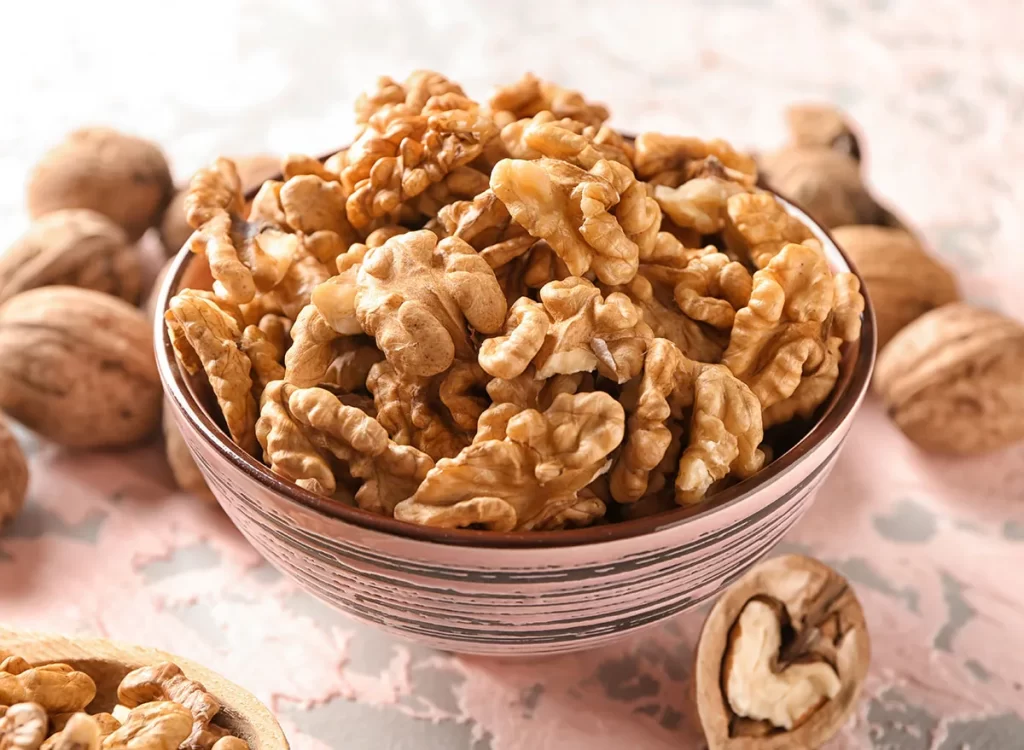
Despite their 65 percent fat content, walnuts do not increase your risk of becoming obese because they reduce your intake of other foods. This is due to the high fiber content in walnuts, which helps to keep you full for a more extended period of time. The result is a lower calorie intake because it keeps you satiated and reduces the urge to snack between meals.
Protein and polyunsaturated fats are both found in walnuts. This type of fat contains omega3 and omega6 fatty acids, which are suitable for the body. Walnuts also contain Alpha-Linoleic acid, a fatty acid that aids in the breakdown of fat and improves cardiovascular health. In addition, walnuts, according to research, stimulate the right insula, a part of the brain responsible for controlling food cravings and appetite.
According to a new study, ghrelin, a hunger hormone, may be lowered by eating foods high in polyunsaturated fats. This is because the brain receives hunger cues from ghrelin. Additionally, walnuts’ copper content aids in the development of healthy blood vessels and produces plenty of energy in the body.
Blood pressure is controlled, cholesterol is decreased, and the risk of cardiovascular disease is decreased by consuming a lot of walnuts.
Nutritional Value:
- Calories: 185
- Fat: 18.5 grams
- Protein: 4 grams
- Carbs: 4 grams
- Fiber: 2 grams
- Copper: 50% of the DV
- Magnesium: 11% of the DV
- Manganese: 42% of the DV
To reap the benefits of walnuts, you can eat them both in the morning and at night. It will give you a burst of energy and stamina and help you control your hunger. On the other hand, consuming walnuts at night helps alleviate digestive issues and keeps you regular. Up to seven whole walnuts can be consumed daily.
2. Pistachios
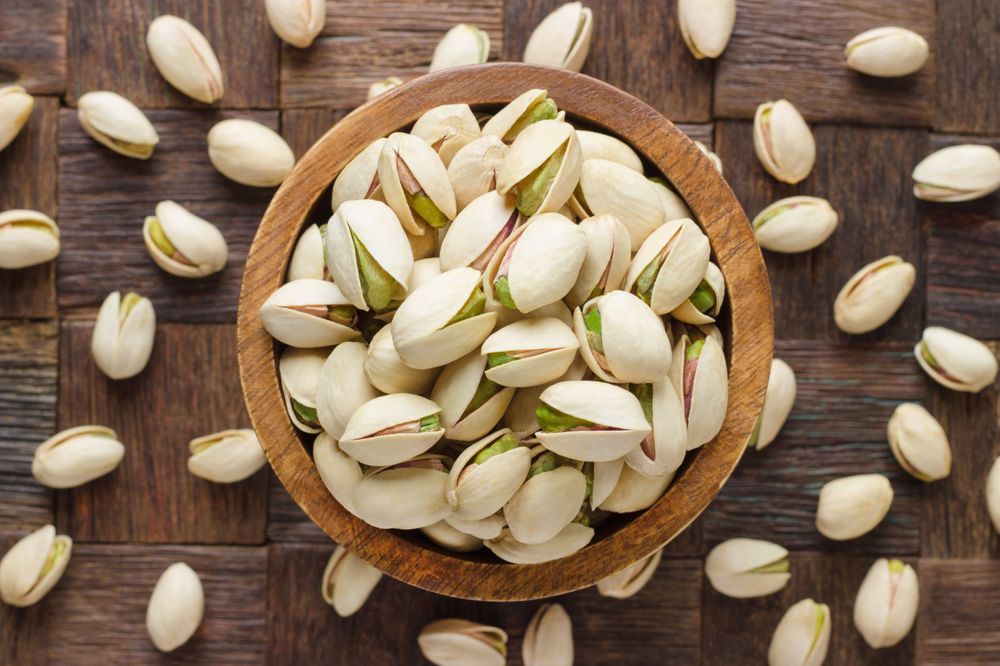
“Pistákion” is an ancient Greek word that referred to green nuts. This nut has been consumed for thousands of years by humans.
Nuts such as pistachios are rich in vitamin B6 and B1 and phosphorus. Another low-fat and low-calorie nut is the Brazil nut. It also has a significant impact on the immune system and metabolism.
According to a study, people who participated in a weight loss program, regardless of whether or not they ate pistachios, lost weight. Although pistachio consumption has been linked to lower blood pressure and increased antioxidant levels in the blood, this is not the case for everyone. The fiber in pistachios keeps you feeling fuller for longer, so you’re less likely to snack between meals. Your weight-loss efforts will benefit from this.
Antioxidants like flavonoids, carotenoids, lutein, zeaxanthin, anthocyanins, and proanthocyanidins abound in pistachios. This group of anti-inflammatory antioxidants also helps reduce the risk of cardiovascular disease, as well as lower levels of blood pressure, glucose, and triglycerides.
Nutritional Values:
28 grams of pistachios contain:
- Calories: 185
- Fat: 18.5 grams
- Protein: 4 grams
- Carbs: 4 grams
- Fiber: 2 grams
- Copper: 50% of the DV
- Magnesium: 11% of the DV
- Manganese: 42% of the DV
3. Almonds
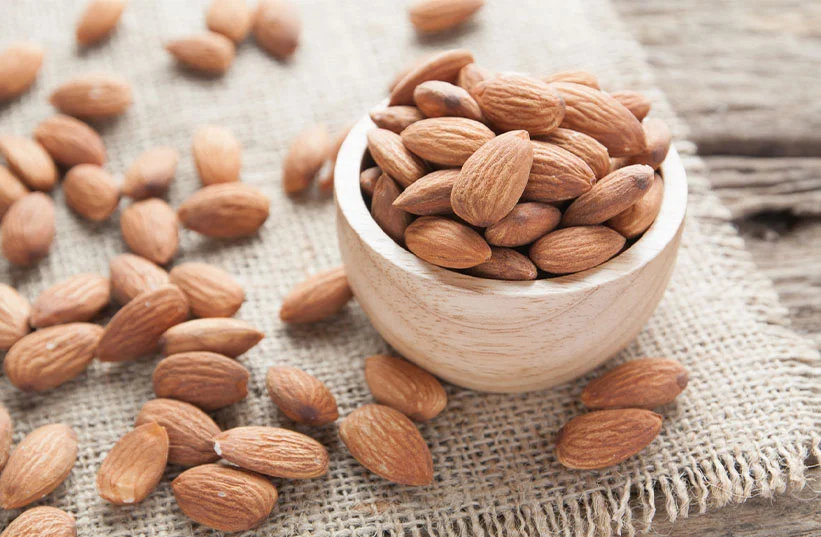
In terms of dried fruits, almonds are the most popular, mainly because of their health benefits for the brain and heart. In addition, fiber, protein, vitamin E, magnesium, and numerous other minerals and antioxidants abound in this superfood.
As a result, almonds help lower bad LDL cholesterol and reduce fat because of their high fiber content. In addition, people who followed a high-almond diet lost an additional pound of weight compared to those who followed a high-carb diet with the same number of calories consumed.
Another study shows that almonds can help you lose weight. A total of 65 people with type 2 diabetes who were overweight were included in the study. It was found that 70% consumed 1000 calories of liquid and 3oz of almonds, while 30% ate a similar diet with complex carbs. Weight and BMI [body mass index] was reduced by 18 percent and 14 percent, respectively, in those who ate an almond-rich diet. The weight loss in the other group was only 11%, and the reduction in waist circumference was only 9%. So, if you’re trying to lose belly fat, almonds might be able to help.
Due to their high vitamin E and fat-soluble nutrient content, almonds also help to support the immune system, communicate between cells, and prevent oxidative damage to cells. In addition, bifidobacteria and Lactobacillus species thrive in the presence of almonds. These microorganisms help to maintain a healthy digestive system.
Nutritional Values:
28 grams of roasted almonds contain:
- Calories: 170
- Fat: 15 grams
- Protein: 6 grams
- Carbs: 6 grams
- Fiber: 3 grams
- Vitamin E: 45% of the Daily Value (DV)
- Magnesium: 19% of the DV
- Manganese: 27% of the DV
There are numerous advantages to consuming nuts first thing in the morning. It’s because eating almonds in the morning will maximize their health benefits. You should eat six to eight almonds a day as a snack.
4. Cashews
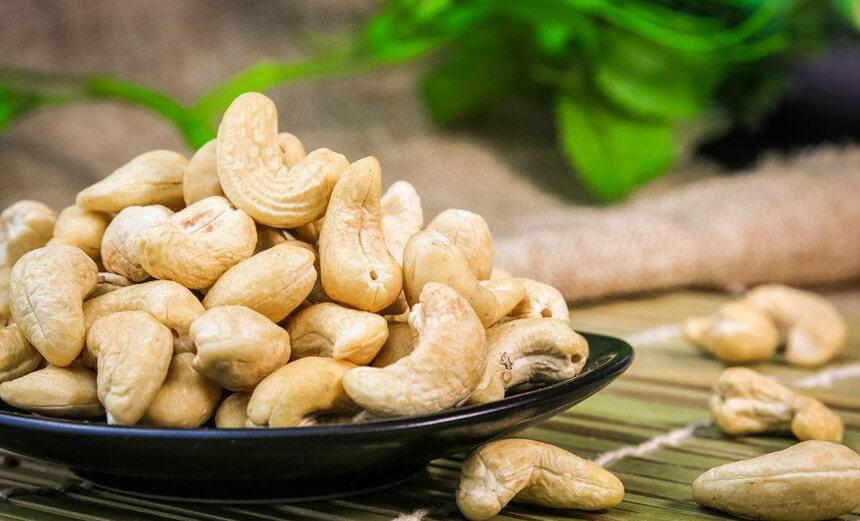
A wide range of health benefits to eating cashews, including high levels of protein and vitamins K and magnesium, as well as iron, selenium, copper, manganese, and dietary fiber. Our bodies benefit from all of these nutrients.
Unsaturated fats found in cashews help protect against heart disease and premature death. These foods are also high in fiber and protein and low in sugar. As a result, cashews help you control your caloric intake and shed pounds. Nonetheless, when incorporating cashews into a weight-loss diet, keeping the serving size in mind is essential.
As an added benefit, magnesium aids in weight loss by regulating your body’s metabolism of carbs and fat. That said, cashews have the same amount of protein per serving as nuts like meat. As a result, cashews are a high-protein nut. Protein and magnesium aid in weight loss by increasing metabolism and decreasing hunger.
In addition to providing essential nutrients for bone and energy production, cashews also help to improve brain health and strengthen the body’s defenses. Cashews’ magnesium, copper, mineral, and manganese content is to thank for this.
Nutritional Values:
28 grams of cashews contain:
- Calories: 155
- Fat: 12 grams
- Protein: 5 grams
- Carbs: 9 grams
- Fiber: 1 gram
- Vitamin K: 8% of the DV
- Magnesium: 20% of the DV
- Manganese: 20% of the DV
5. Hazelnuts
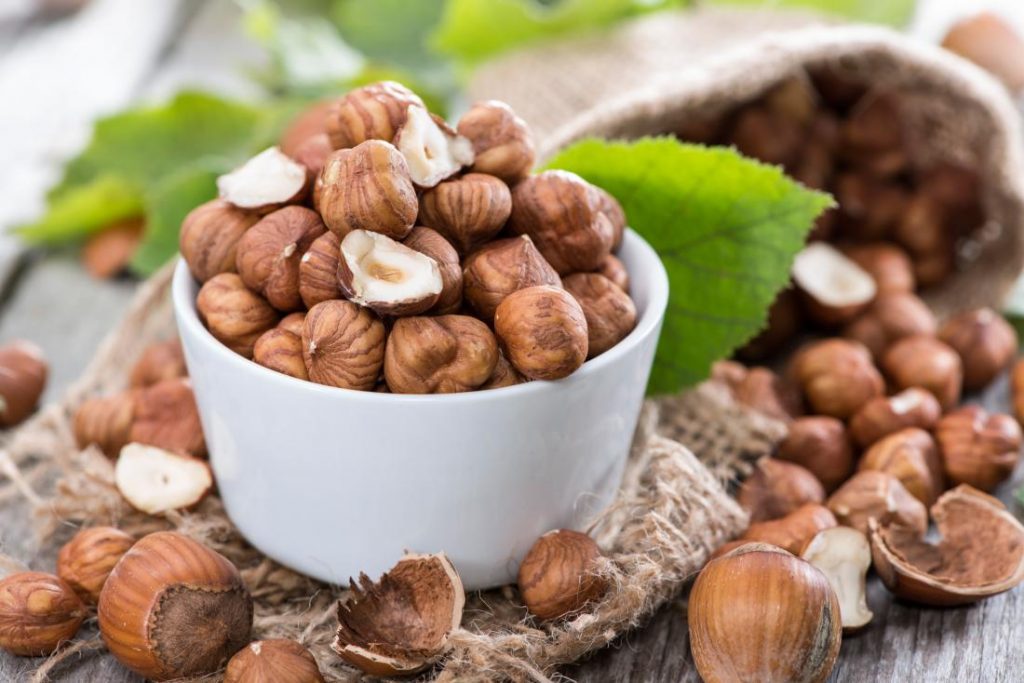
Filbert, another name for hazelnut, is primarily grown in Italy, Spain, Turkey, and the United States of America.
Thermogenesis, the production of heat, is boosted by consuming hazelnuts. Excess calories are burned when the body raises its core temperature. Furthermore, the fat found in hazelnuts is excreted in the stool rather than absorbed by the body. The extra inches can be shed by incorporating hazelnuts into your diet.
In addition to being an excellent source of nutrients, hazelnuts are also a good source of fiber. These vitamins and minerals have been shown to help with weight loss, immunity, bone density, and cognitive function.
Antioxidants and plant compounds like caffeic acid, quercetin, epicatechin, and gallic acid found in hazelnuts help reduce the body’s anti-inflammatory effects.
Nutritional Values:
28 grams of hazelnuts contain:
- Calories: 178
- Fat: 17 grams
- Protein: 4 grams
- Carbs: 5 grams
- Fiber: 3 grams
- Vitamin E: 28% of the DV
- Magnesium: 11% of the DV
- Manganese: 76% of the DV
Hazelnuts are a great source of nutrition if you eat them in the morning or before lunch. As a result, a daily serving size of about 20 hazelnuts is suggested. Those with type 2 diabetes should eat nuts at least once a week.
You should eat nuts for weight loss in the morning or before working out if you want the best results. They’re best eaten at this time. The reason for this is that nuts are high in fat, and your body requires some physical activity in order to absorb and digest the fats. Nuts, on the other hand, are beneficial for weight loss.
You can boost your immune system and stamina by eating pistachios and cashews in the evenings. A handful of these nuts can be eaten as an evening snack to keep you going strong.
Other Benefits of Consuming Nuts
1. Cholesterol and Triglycerides
Nuts are well-known for their ability to help lower cholesterol, particularly harmful LDL cholesterol. The monounsaturated and polyunsaturated fatty acids found in nuts account for this. These acids aid in the maintenance of a healthy cardiovascular system. As a result, they help reduce cardiovascular disease and lower cholesterol and inflammation.
Maintaining triglycerides is good for the body because they provide the body with the energy it needs. Increased levels of blood triglycerides, on the other hand, cause the hardening and thickening of arteries. As a result, heart attacks and other cardiovascular ailments rise. High triglyceride levels also cause acute pancreas inflammation.
Nuts can help lower cholesterol and triglyceride levels and lower the risk of heart disease and stroke. Nuts such as pistachios can help lower cholesterol levels and lower triglycerides. The best way to raise good HDL cholesterol and control lousy LDL cholesterol is to consume almonds and hazelnuts.
2. Nuts Reducing Inflammation
As a source of anti-inflammatory flavonoids and other antioxidants such as zeaxanthin, anthocyanins, and proanthocyanidins, nuts are a good source of these nutrients. The anti-inflammatory properties of nuts are a result of this fact.
Injury, bacteria, and potentially harmful pathogens contribute to inflammation, which manifests as swelling, redness, and soreness. When the inflammation is severe, it can damage organs and put the patient at risk for various diseases.
Eating pistachios, almonds, and hazelnuts can reduce inflammation and oxidative stress, all of which have anti-inflammatory properties.
Including nuts in one’s diet has several advantages, according to a study on the Mediterranean diet. For example, they saw a 35% and 90% decrease in the inflammatory markers CRP and IL-6, respectively, due to the supplementation.
3. Type 2 Diabetes and Metabolic Syndrome
Diabetic type 2 is a life-threatening condition. Higher blood sugar levels result from insulin that isn’t working correctly or insufficient insulin production by the pancreas. Persistently elevated blood sugar levels bring on metabolic syndromes. As a result, heart disease, stroke, and type 2 diabetes may be more likely to occur. Insulin and metabolic syndrome are closely linked, as evidenced by this correlation.
Type 2 diabetes and metabolic syndrome benefit greatly from the consumption of nuts.
Some studies have shown that nuts help control blood sugar levels after meals. This test shows how much glucose is in your blood after eating a meal. When eaten with high-glycaemic index carbohydrate foods, nuts can reduce the postprandial glycaemic response. Those who are neither normoglycemic nor Type 2 diabetic will experience this.
Nuts may help lower blood pressure and other diabetes and metabolic syndrome-related health indicators. In addition, oxidative stress in the body can also be reduced by taking this supplement.
4. Reduce the Risk of Heart Diseases
Nuts are rich in polyunsaturated and monounsaturated fats, which suit you. Adding these fats to your diet can help keep your heart healthy and nourished. Nuts also contain nutrients and antioxidants that are good for the heart and lower cholesterol levels by reducing inflammation in the cardiovascular system.
Smaller, more dense LDL particles have been linked to an increased risk of heart disease. However, compared to other food sources of cholesterol, nuts help raise good HDL levels and lower harmful LDL levels. This reduces the risk of heart attack, heart failure, and other life-threatening heart conditions.
It has been found that people who consume nuts may experience a significant reduction in small LDL particles and an increase in HDL cholesterol.
Nuts to Avoid for Weight Loss
1. Macadamia Nuts
Vitamin B1, omega9 fatty acids, magnesium, and manganese are all found in macadamia nuts. When combined, these nutrients can cause you to gain weight, making it difficult to lose weight.
2. Pecans
Pecans are high in fat and calories, making them an excellent source of both. Pecans, for example, have 691 calories per 100 grams. Therefore, consuming more pecans means consuming more calories, which goes against the grain of losing weight.
3. Peanuts
One ounce of peanuts contains 187 calories and 19 grams of fat, making them a high-calorie food. As a result, if you eat a lot of it regularly, you may not be able to lose weight.
4. Brazil Nuts
Saturated fat is found in abundance in Brazil nuts. Saturated fat intake is linked to higher levels of bad cholesterol and a slower rate of weight loss. Even weight gain can be a side effect of this. High-fat content in food also slows the metabolic rate.
Precautions
There are some things to remember when eating nuts, even though they are considered highly nutritious and heart-healthy. Consume nuts, for example, sparingly and only in the recommended serving sizes. Nuts can cause weight gain if consumed in excess.
Heart disease, high blood pressure, and clogged arteries can be caused by an imbalance in omega fatty acids and saturated fats.
Nuts, whether dry roasted or raw, are best consumed in their natural form. Nuts should be roasted without the use of oil or any other flavorings like salt. Sugar and chocolate-coated nuts should also be avoided. Don’t eat nuts high in calories and fat at night to avoid disrupting your sleep and digestion.
Conclusion
Nuts are an excellent source of heart-healthy fats, antioxidants, vitamins, and minerals, and they’re also a good source of fiber. Naturally, the antioxidant and nutritional value of different nuts varies. However, each type of nut has its unique advantages. Some nuts, for example, may aid weight loss, while others may improve cognitive function or even the appearance of the skin.
If you want to avoid potential side effects, eating your food correctly and at the right time is always best. To get the most out of the nuts, choose the ones that are most beneficial to your health.




